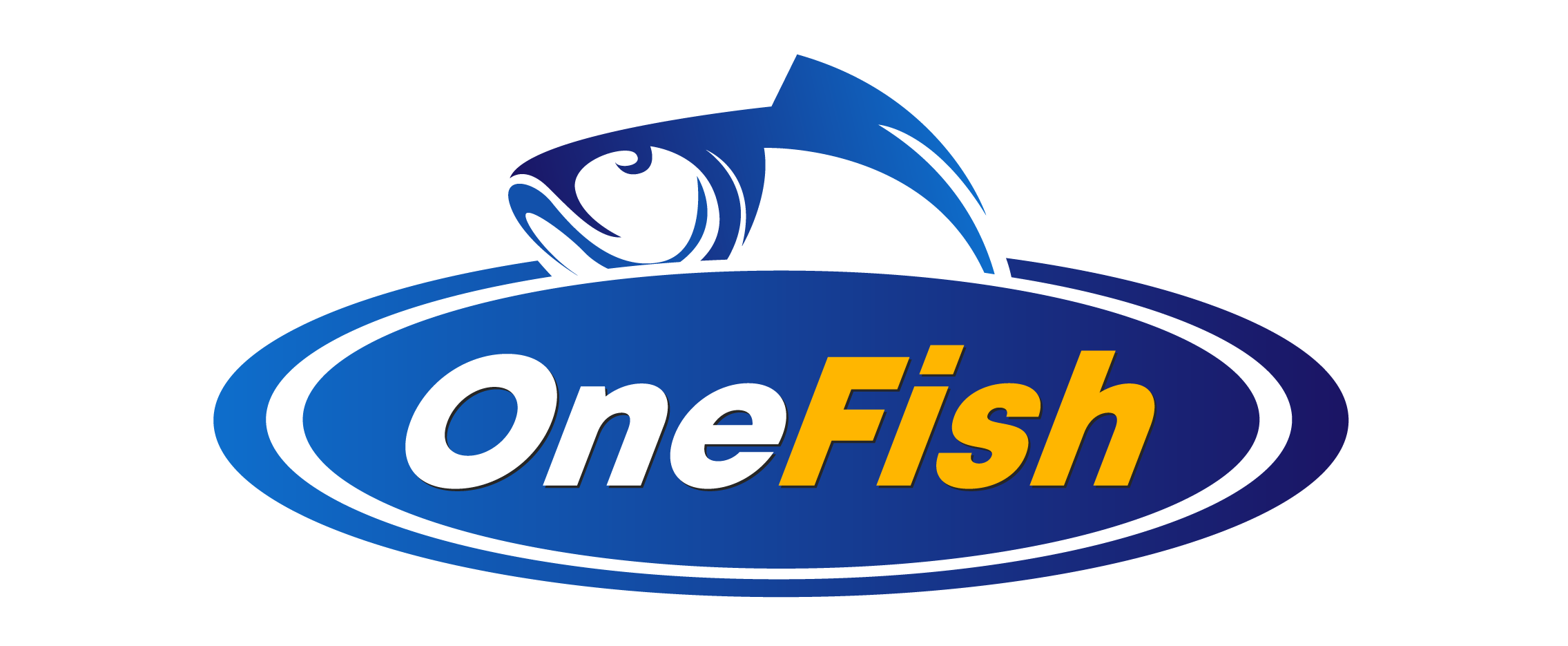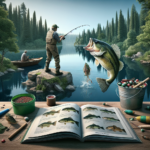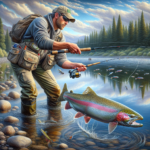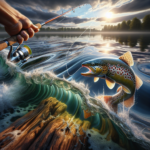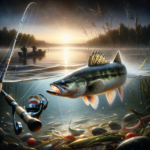Fishing Tips on How to Catch Lake Trout
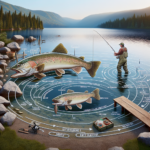
Introduction
Lake trout, scientifically known as Salvelinus namaycush, are a prized catch among anglers due to their size, strength, and the challenge they present. These fish are native to North America and are highly sought after in sport and recreational fishing. This article will provide a comprehensive guide on how to catch lake trout, covering everything from their physical characteristics and behavior to the best fishing techniques, gear recommendations, and common mistakes to avoid.
Fish Species Overview
Description
Lake trout are easily recognizable by their elongated bodies, deeply forked tails, and distinctive coloration. They typically have a dark green to grayish body with light-colored spots scattered across their sides. The average size of lake trout can vary significantly, but they commonly range from 20 to 30 inches in length and can weigh between 5 to 15 pounds. However, trophy-sized lake trout can exceed 40 inches and weigh over 30 pounds.
Habitat
Lake trout are primarily found in freshwater environments, particularly in deep, cold lakes. They thrive in clear, oxygen-rich waters and are commonly found in the northern regions of North America, including the Great Lakes, Canadian Shield lakes, and various alpine lakes. They prefer depths ranging from 50 to 200 feet, depending on the season and water temperature.
Behavior
Lake trout are opportunistic feeders, preying on a variety of fish species, insects, and crustaceans. Their feeding habits can vary with the seasons; they tend to feed more aggressively during the spring and fall when water temperatures are cooler. Spawning typically occurs in the fall, with lake trout seeking out rocky or gravelly areas in shallow waters to lay their eggs. They are most active during the early morning and late evening hours, making these times ideal for fishing.
Challenges
One of the main challenges anglers face when targeting lake trout is their preference for deep, cold waters, which can make them difficult to locate and reach. Additionally, their feeding patterns can be unpredictable, requiring anglers to be adaptable and patient.
Best Time to Catch Lake Trout
Seasonal Considerations
The optimal seasons for catching lake trout are spring and fall. During these times, the water temperatures are cooler, and lake trout are more likely to be found in shallower waters, making them more accessible to anglers. In the summer, lake trout tend to retreat to deeper, cooler waters, which can make them more challenging to catch.
Time of Day
Lake trout are most active during the early morning and late evening hours. These times offer the best chances of success, as the fish are more likely to be feeding near the surface or in shallower waters. Midday fishing can also be productive, especially if you target deeper areas where lake trout may be seeking refuge from warmer surface temperatures.
Weather Conditions
Ideal weather conditions for lake trout fishing include overcast skies and calm waters. Cloudy days can reduce light penetration, making lake trout more likely to venture into shallower waters. Calm waters also make it easier to detect bites and manage your fishing gear effectively.
Top Fishing Techniques for Lake Trout
Technique 1: Trolling
Trolling is one of the most effective techniques for catching lake trout. This method involves dragging lures or baited hooks behind a moving boat at various depths. Trolling allows you to cover a large area and locate active fish. Using downriggers or lead-core lines can help you reach the deeper waters where lake trout often reside.
Technique 2: Jigging
Jigging is another popular technique for targeting lake trout, especially in deeper waters. This method involves vertically dropping a weighted lure or jig and then rhythmically lifting and lowering it to mimic the movement of prey. Jigging can be highly effective when lake trout are concentrated in specific areas, such as near underwater structures or drop-offs.
Technique 3: Casting
Casting can be an effective technique for catching lake trout, particularly in shallower waters during the spring and fall. Using spoons, spinners, or swimbaits, you can cast your lure and retrieve it at varying speeds to entice strikes. This method allows for precise targeting of specific areas, such as rocky shorelines or weed beds.
Pro Tips
- Vary Your Speed: When trolling or retrieving lures, vary your speed to mimic the erratic movement of prey and trigger strikes.
- Use Electronics: Fish finders and sonar can help you locate schools of lake trout and determine the optimal depths to fish.
- Match the Hatch: Pay attention to the local forage species and use lures or baits that closely resemble them.
Recommended Gear for Catching Lake Trout
Fishing Rod and Reel
For lake trout fishing, a medium to medium-heavy rod with a fast action is recommended. This provides the sensitivity needed to detect bites and the strength to handle larger fish. Pair your rod with a high-quality spinning or baitcasting reel with a smooth drag system.
Fishing Line
Braided line with a fluorocarbon leader is a popular choice for lake trout fishing. Braided line offers excellent strength and sensitivity, while fluorocarbon is nearly invisible underwater. A line strength of 10 to 20 pounds is typically sufficient, depending on the size of the fish you are targeting.
Hooks and Baits
When it comes to hooks, sizes 4 to 1/0 are commonly used for lake trout. For natural baits, consider using minnows, smelt, or nightcrawlers. Artificial lures such as spoons, swimbaits, and jigs can also be highly effective.
Additional Gear
- Downriggers: Essential for reaching deeper waters when trolling.
- Fish Finder: Helps locate schools of lake trout and determine optimal fishing depths.
- Net: A sturdy landing net is crucial for safely landing larger fish.
Best Locations to Find Lake Trout
General Locations
Lake trout are typically found in deep, cold freshwater lakes. They prefer clear, oxygen-rich waters and are often associated with rocky or gravelly substrates. Look for them near underwater structures, drop-offs, and thermoclines.
Specific Regions
Some of the most popular regions for lake trout fishing include the Great Lakes (particularly Lake Superior and Lake Michigan), Canadian Shield lakes (such as Lake Athabasca and Great Slave Lake), and various alpine lakes in the Rocky Mountains.
Common Mistakes to Avoid
Mistake 1: Fishing Too Shallow
One common mistake is fishing too shallow, especially during the summer months when lake trout retreat to deeper waters. Use a fish finder to locate the optimal depths and adjust your techniques accordingly.
Mistake 2: Using the Wrong Gear
Using gear that is too light or too heavy can hinder your success. Ensure you have the appropriate rod, reel, line, and lures for lake trout fishing to maximize your chances of landing a catch.
Mistake 3: Ignoring Local Knowledge
Local anglers often have valuable insights into the best spots, techniques, and baits for catching lake trout in a specific area. Don’t hesitate to seek advice from local fishing shops or experienced anglers.
Catch and Release Tips
Importance of Conservation
Practicing catch and release is crucial for maintaining healthy lake trout populations and ensuring future generations can enjoy this sport. Ethical fishing practices help preserve the ecosystem and promote sustainable fishing.
Proper Handling Techniques
- Use Barbless Hooks: Barbless hooks make it easier to release fish with minimal injury.
- Minimize Handling: Use a landing net and wet your hands before handling the fish to protect its slime coat.
- Quick Release: Keep the fish in the water as much as possible and release it quickly to reduce stress.
Legal Considerations
Be aware of local regulations regarding size limits, bag limits, and protected areas. Always check the latest fishing regulations before heading out to ensure compliance with conservation laws.
Frequently Asked Questions (FAQs)
What is the best bait for catching lake trout?
The best baits for lake trout include live minnows, smelt, and nightcrawlers. Artificial lures such as spoons, swimbaits, and jigs can also be highly effective. The choice of bait may vary depending on the season, water conditions, and local preferences.
Where is the best place to fish for lake trout?
Lake trout are commonly found in deep, cold freshwater lakes. Popular fishing spots include the Great Lakes, Canadian Shield lakes, and alpine lakes in the Rocky Mountains. Look for them near underwater structures, drop-offs, and thermoclines.
What time of day is best for catching lake trout?
The early morning and late evening hours are the best times to catch lake trout, as they are most active during these periods. Midday fishing can also be productive, especially if you target deeper areas where lake trout may be seeking refuge from warmer surface temperatures.
What type of fishing line should I use for lake trout?
Braided line with a fluorocarbon leader is recommended for lake trout fishing. Braided line offers excellent strength and sensitivity, while fluorocarbon is nearly invisible underwater. A line strength of 10 to 20 pounds is typically sufficient.
Do I need a special fishing license to catch lake trout?
Fishing license requirements vary by location. In most areas, you will need a valid fishing license to catch lake trout. Be sure to check local regulations for specific licensing requirements, size limits, bag limits, and any special permits needed.
What is the best technique for catching lake trout?
Trolling, jigging, and casting are all effective techniques for catching lake trout. Trolling allows you to cover a large area and locate active fish, while jigging is ideal for targeting specific depths. Casting can be effective in shallower waters during the spring and fall.
Are there any specific weather conditions that improve the chances of catching lake trout?
Overcast skies and calm waters are ideal weather conditions for lake trout fishing. Cloudy days can reduce light penetration, making lake trout more likely to venture into shallower waters. Calm waters also make it easier to detect bites and manage your fishing gear effectively.
Can I catch lake trout from the shore, or do I need a boat?
While lake trout are often found in deeper waters, it is possible to catch them from the shore, especially during the spring and fall when they move into shallower areas. However, having access to a boat can significantly increase your chances of success by allowing you to reach deeper waters and cover more ground.
How can I improve my chances of landing a big lake trout?
To improve your chances of landing a big lake trout, use larger baits or lures that mimic the size of their natural prey. Focus on fishing during the early morning or late evening hours when they are most active. Additionally, target deeper waters and areas with underwater structures where larger fish are likely to be found.
What should I do if I plan to release lake trout after catching them?
If you plan to release lake trout after catching them, practice ethical catch and release techniques. Use barbless hooks, minimize handling, and keep the fish in the water as much as possible. Wet your hands before handling the fish to protect its slime coat and release it quickly to reduce stress.
Conclusion
Lake trout fishing offers a rewarding challenge for anglers of all skill levels. By understanding their behavior, using the right techniques and gear, and practicing ethical fishing practices, you can increase your chances of success and contribute to the conservation of this valuable species. Whether you’re a seasoned angler or a beginner, the tips provided in this article will help you on your next lake trout fishing adventure. So grab your gear, head to your favorite fishing spot, and enjoy the thrill of catching lake trout!
